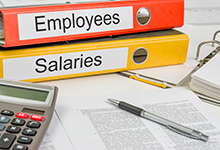Effective 1 March 2023: New Earnings Threshold and National Minimum Wage

Employers and employees need to keep an eye on the annual increases in both the National Minimum Wage and the Earnings Threshold, summarised below for your convenience. Both are effective from 1 March 2023.
The National Minimum Wage increase
The National Minimum Wage (NMW) for each “ordinary hour worked” has been increased by 9.6% from R23-19 to R25-42. Workers who have concluded learnership agreements in terms of the Skills Development Act are entitled to a sliding scale of allowances.
Domestic workers
Domestic workers were brought into line with the NMW in 2022, and assuming a work month of 21 days x 8 hours per day, R25-42 per hour equates to R4,270-56 per month. The Living Wage calculator will help you check whether or not you are actually paying your domestic worker enough to cover a household’s “minimal need” (adjust the “Assumptions” in the calculator to ensure that the figures used are up to date).
The Earnings Threshold Increase
The annual earnings threshold above which employees lose some of the protections of the Basic Conditions of Employment Act has been increased by 7.6% from R224,080-48 p.a. (R18,673-87 p.m.) to R241,110-59 p.a. (R20,092-55 p.m.).
“Earnings” (for this purpose only) means “the regular annual remuneration before deductions, i.e. income tax, pension, medical and similar payments but excluding similar payments (contributions) made by the employer in respect of the employee: Provided that subsistence and transport allowances received, achievement awards and payments for overtime worked shall not be regarded as remuneration”.
Some employees enjoy only limited BCEA protection even if they earn below the threshold – notably any “senior managerial employee” (“an employee who has the authority to hire, discipline and dismiss employees and to represent the employer internally and externally”), any “sales staff who travel to the premises of customers and who regulate their own hours of work” and any “employees who work less than 24 hours a month for an employer”. Take specific advice for details.
The threshold also impacts on some of the protections provided in the Labour Relations Act –
- Employees earning less than the threshold, if contracted to a client for more than three months through a temporary employment service (“labour broker”) are deemed to be employed by the client unless they are actually performing a temporary service.
- Fixed-term employees earning below the threshold are deemed to be employed indefinitely after three months unless the employer has a justifiable reason for fixing the term of the contract.
Turning to the Employment Equity Act, employees earning over the threshold can only refer unfair discrimination disputes (other than disputes based on sexual harassment) to the Commission for Conciliation, Mediation and Arbitration (CCMA) with the consent of all parties. Otherwise, they must go to the Labour Court for arbitration.
Five Essential Bookkeeping Tips for Small Businesses

“Making good judgements when one has complete data, facts, and knowledge is not leadership – it’s bookkeeping” (Dee Hock, Founder and CEO of VISA)
When running a small business, it often feels like you are doing everything yourself, and some important tasks can slip under the radar. One aspect that should never be forgotten though is bookkeeping. While intimidating, keeping your finances in order need not be as hard as it sounds. Here are our tips for ensuring your accounts remain ordered and your peace of mind intact.
- Ask your accountantIf you want to keep things as simple as possible and guarantee you never run foul of the law, getting your accountant in to do your bookkeeping is the safest and most efficient way to do your books. Apart from being able to manage your finances, an accountant would be able to help save on taxes and advise you on areas of the business that may be streamlined.
- Keep your personal and business accounts separateIt may not seem like much, but mixing up which account pays for what can lead to hundreds of extra hours of work over the course of a year working out which deductions and expenses relate to your business. Rather keep personal and business accounts and banking separate.
- Set up reminders for important deadlinesUsing an online calendar, it’s now easy to set up reminders for all those important tax and other deadline dates so you know when things are becoming urgent.
- Keep receiptsBe sure to keep all receipts to build a verifiable audit trail. Whenever you pay anything out to a supplier it’s important to get an invoice and file it away. Keep all your receipts for all business expenses and purchases. You never know when you may be hit with an audit and need to prove everything you have said.
- Keep reports
Every month generate a one-page document detailing all your income and expenditure. Ask your accountant to set up a simple monthly one-page report that, in addition, compares actual income and expenses to your budget. It doesn’t have to be detailed but should give you an idea of just where the money is going and what is coming in. As well as making bookkeeping easier, it will also help you track the growth and health of your company.
How To Prepare a Reliable Disaster Recovery Plan

“The time to prepare for disasters is before they happen” (Stephen Matheson, Vice President of Product at BridgeHead)
Given how reliant we all are on our IT infrastructure, it will come as no surprise to learn that one of the worst things that can happen to a business is for a failure to occur in that department. Whether it’s fire, floods, or hacking, being taken offline can spell a serious period of trouble for most organisations. In the time it takes to get back up and operational projects can be delayed, the quality of work can suffer, or worst of all, everything is put on hold for months while data is recreated. All of this can lead to strained relationships with both customers and suppliers and potentially the end of the business.
A Disaster Recovery Plan is the pre-planned process a company will turn to when disaster strikes to ensure that a short-term problem does not become a permanent one.
Here are five simple tips for what you need to consider when drawing one up.
- Have a response checklistThe response checklist is a detailed breakdown of which employees should be contacted and what they should do in the event of a disaster. These should cover everything from who phones your IT support company to who puts out the fire or organises the evacuation drill. Ideally, these responses should be practiced. It’s no good telling someone they have to turn off the building’s water in the event of a flood if they don’t know where to do that.
- Have a data backup planAll company data needs to be backed up, as regularly as possible. How this is done will depend on how vital that data is to the operational capabilities of your business but should happen at least once a day. Look at your company carefully and decide which information is vital and which can safely be lost. You don’t need to back up all your client emails if you also keep other records of their projects for instance.Data is a business asset and has real value. The more important the data, the more strictly and safely that data needs to be backed up. Can you do it yourself on a hard disk that the secretary takes home, or do you need a full-scale external, cloud-based solution?
- How are you going to tell your clients?While it’s usually a good idea to keep drama and difficulties far away from your clients, in this instance it may be important to tell them what is going on to explain any delays they may be about to experience and how you are planning to meet their orders. In addition, provide them with any alternate contact details.Your plan should detail exactly how that is going to happen. Having pre setup and approved email addresses and telephone numbers organised will save a lot of time and frustration until your company is back on its feet.
- Cost considerationsYour plan should also take into account the cost considerations of setting things up anew. Will you need to buy new servers? Do you need to bring in IT experts to recover data? The money for this should be set aside and available as every day you delay your recovery is another step closer to bankruptcy.Speak with your accountant as to how you can finance this fund, or whether insurance options may be a financially viable option for your company.
- Vital document and data storage
On top of all of this, your Disaster Recovery Plan should also detail where copies of all the most vital information will be stored and how they can be retrieved. This should be a safe and secure offsite location. Keys and access codes need to be kept in a third location as well.
